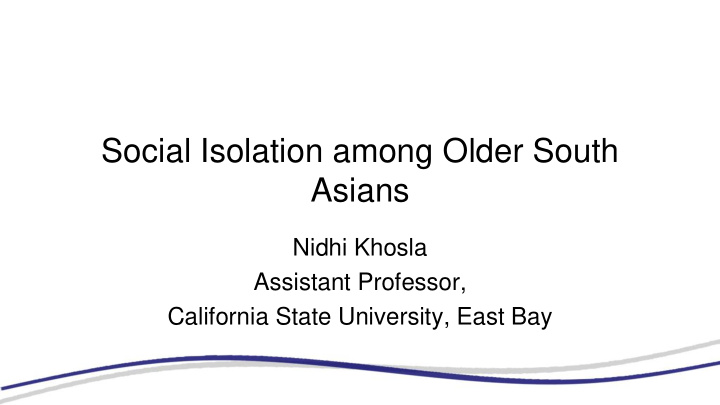



Social Isolation among Older South Asians Nidhi Khosla Assistant Professor, California State University, East Bay
Aging Minorities in the US 20 percent of the U.S. population will be older than 65 by 2050 (Dying in America, 2014) 20% of older adults are racial or ethnic minorities (Johnson, K.S. 2013) By 2035, growth in the proportion of minority older adults will substantially outpace that of Non-Hispanic whites (Johnson, K.S. 2013)
South Asians in the US • Individuals with origins in India, Pakistan, Bangladesh, Nepal, Sri Lanka, Bhutan and Maldives • Approximately 3.8 million, 80% growth rate over 2000-2010 • Over 75% South Asians are foreign-born • >80% of US South Asians are of Indian origin
South Asians in the US contd … • During 50 years before 1965 quota restrictions limited Asian entry to 100 immigrants • After 1965, change in Immigration and Naturalization Act led to entry of young, highly educated Asian immigrants who are now at the retirement age • 1980s and 1990s, family reunification led to entry of older Asian immigrants
Diversity among South Asians Hinduism Cultural Buddhism Similarities Islam Hindi Limited Urdu English Bangla Proficiency >28 other languages 5
Social Isolation • Social isolation results from fewer social contacts or meaningful relationships than are desired by the person • South Asians are at risk for social isolation due to language barriers, small social networks, and cultural differences • Age-related health issues, and poverty may worsen problems in participation in social and cultural life • Filial expectations of care may not be met • Living in multigenerational households may cause conflict and worsen loneliness • 37% elders living with family reported loneliness, in a Canadian study
Cultural Nuances affecting Social Isolation • South Asian elderly grew up in collectivistic societies where family loyalty and frequent gatherings to celebrate festivals, marriages, births and deaths were important • Older age associated with wisdom, decision-making power and wealth • Living in the US can lead to role reversal as younger members teach the elders mainstream cultural mores, language and day-to-day matters
Needs of Older South Asians • Transportation to cultural centers & visit friends, among others • Healthcare especially dental and eye care • Housing – Ethno-specific care homes with traditional food, caregivers conversant with languages and culture – Culturally-sensitive home care services to enable living at home • Faith-based or cultural groups for socializing and information provision • Confidential services to help with elder abuse
Research/Practice Agenda • Investigate South Asians’ experiences of loneliness and isolation and develop programs to address these • Expanding data collection to modalities such as vignettes to collect data on sensitive subjects • Building capacity of local community based organizations to serve South Asians’ needs • Promote access to education and information within the South Asian community
Thank You!
Recommend
More recommend